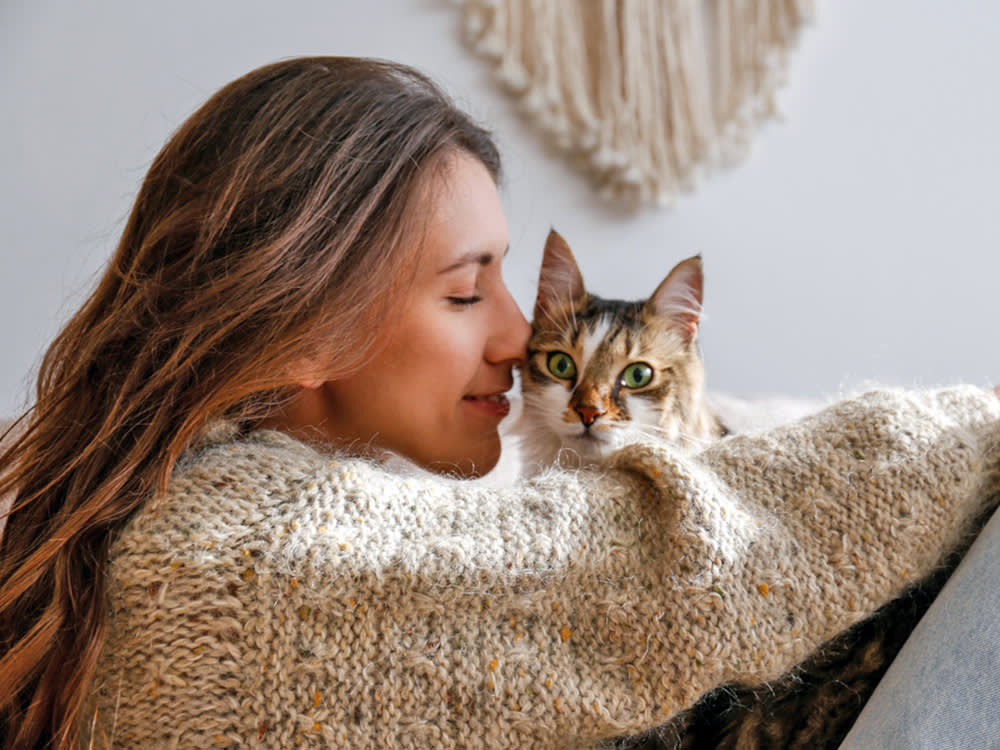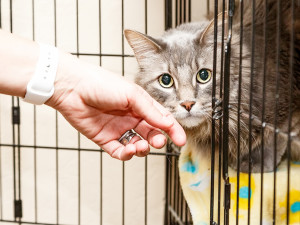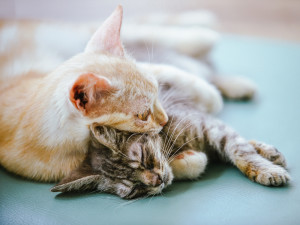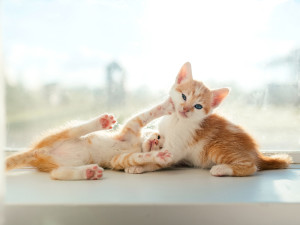
Share Article
In this article:
Why should you adopt a cat? Cat adoption process Where to adopt a cat How much does it cost to adopt a cat? How long does it take to adopt a cat? How to prepare your home for your new cat Cat adoption FAQs
Adopting a cat is one of the most rewarding decisions you can make, providing you with a furry companion while giving a deserving animal a second chance at a loving home. With thousands of cats waiting in shelters and rescue centres across the UK, this guide will walk you through everything you need to know about the adoption process.
Why should you adopt a cat?
By adopting, you’re offering a cat a fresh start and helping shelters care for more animals in need and, in case you haven’t heard, shelters are full to the brim right now. The RSPCA says its animal rehoming centres are at ‘breaking pointopens in new tab’. Also, most rescue cats come already vaccinated, microchipped, neutered and health-checked, saving you significant initial veterinary costs.
“One of the biggest misconceptions I’ve heard is that cats adopted from a rescue charity will be old or unhealthy, or have behavioural or medical issues,” says Tania Marsh, Deputy Manager of the UK Cat Centre of Cats Protectionopens in new tab. “In fact, you’ll find a broad spectrum of very healthy cats at rescue centres that are in need of a new home for a multitude of different reasons.”
Adoption also typically comes with support from experienced staff who can match you with a cat suited to your lifestyle and provide ongoing advice about cat care.
Cat adoption process
The process of adopting a cat in the UK follows a fairly standard pattern across most shelters and rescue organisations, though specific details may vary slightly. Here’s what you can generally expect:
1. Search for cats available for adoption
Start by searching rescue organisations’ websites, where you can filter cats by age, gender, temperament and location.
Marsh from Cats Protection explains their process: “To adopt a cat, visit our websiteopens in new tab and pop your postcode into the ‘Find a cat’ feature to view Cats Protection cats in need of homes in your area.”
Other major UK animal welfare organisations like the RSPCAopens in new tab, Blue Crossopens in new tab and Batterseaopens in new tab also maintain searchable databases of cats awaiting homes.
2. Find a cat you’d like to adopt
Once you’ve identified potential matches, arrange to meet them in person. This important step helps ensure there’s a connection between you and your potential new pal.
Marsh advises considering your lifestyle when choosing between a kitten, adult cat or senior cat. Kittensopens in new tab need more time and patience. Adult cats are typically more settled and easier to integrate into your home. For quieter households, cats over seven years (”mature moggies”) are ideal, as they tend to be calmer and less likely to wander.
3. Complete an adoption application
After meeting potential cats, you’ll need to complete an adoption application. This typically includes questions about your living situation, experience with pets, your home environment, work schedule, and other relevant details to help determine if you’re a suitable match for the cat you’ve chosen. These applications ensure your kitty is being put into safe hands and will help create successful, lasting matches.
4. Application approval
Your application will be reviewed by the rescue organisation’s team. This can take anywhere from a few days to a couple of weeks, depending on the organisation’s resources and procedures. During this time, they may contact references you’ve provided or request additional information to help make their decision.
5. Arrange a home visit
Many rescue organisations conduct home visits as part of the adoption process. This step allows them to ensure your home is safe and suitable for a cat and to address any potential concerns.
Home visitors will typically check for potential hazards, confirm details from your application and may offer advice on cat-proofing your home. Learn more about what to expect during a pet adoption home visit.
6. Pay the adoption fee
Upon approval, you’ll be asked to pay an adoption fee. Fees vary between organisations and sometimes depend on the age of the cat.
At Cats Protectionopens in new tab, the fee typically ranges from £80 to £120. Marsh says this helps cover health checks, parasite treatments, initial vaccinations, neutering for cats over eight weeks and microchipping. Fees vary by location as branches pay different amounts for veterinary care and cat essentials.
7. Take your new cat home
The final and most exciting step is bringing your new cat home! Shelters often provide food, bedding, and care information to ease the transition.
“All being well, you get to take your cat home within a week of meeting them!” Marsh explains. “Please note that we may not have a suitable cat for you at the time you inquire, in which case we can arrange to stay in touch and let you know of suitable cats later.”
Where to adopt a cat
There are several options for adopting cats in the UK:
Animal shelters and rescues
The UK has numerous animal welfare organisations with centres across the country, including:
Local independent rescues
These organisations rehabilitate and rehome thousands of cats annually, with comprehensive veterinary care provided before adoption.
Cat adoption websites
Several websites aggregate listings from multiple shelters, making it easier to search across organisations:
Pets4Homesopens in new tab (includes both rescue animals and those for sale)
Always verify an organisation’s legitimacy before adopting through online platforms.
Breeders
It is possible to adopt pedigree cats from breeders in the UK, although it’s more common to find them through shelters and rescues. Breeders may rehome retired breeding cats (studs or queens) or cats surrendered for various reasons.
If you decide to buy a cat, Marsh recommends referring to Cats Protection’s kitten checklistopens in new tab to help you make the right choice.
How much does it cost to adopt a cat?
The initial adoption fee is just the beginning of your financial commitment. Ensure you’re ready for the lifetime cost of a cat.
Ongoing annual costs typically include:
Yearly health checks and booster vaccinations.
Flea and worming treatments.
Insurance.
Complete cat food.
Toys.
Cat litter.
Based on this, the PDSAopens in new tab estimates the minimum monthly cost of owning a cat to be £64. Marsh notes that many cat owners neglect regular veterinary care, with nearly a million UK cats (9 percent) not registered with a vet. She advises regular check-ups and suggests comparing prices or asking about payment plans if cost is a concern.
How old do you have to be to adopt a cat?
Most rescue organisations require adopters to be at least 18 years old, as adoption constitutes a legal agreement. For those under 18, parents or guardians will need to be the official adopters and take legal responsibility for the animal.
While families with children can certainly adopt, many shelters assess whether particular cats are suitable for homes with young children. Some cats may have had negative experiences with children or simply prefer quieter environments.
How long does it take to adopt a cat?
The timeline varies significantly between organisations and individual circumstances. From initial application to bringing your cat home, the process typically takes 1–3 weeks.
As Marsh mentioned, Cats Protection aims to have cats in their new homes within a week of meeting their potential parents, but this depends on the availability of suitable cats and the completion of necessary checks.
How to prepare your home for your new cat
“A change of environment can be stressful for a cat and it might take a few weeks for them to get used to their new home,” says Marsh. “To help them settle in, prepare a quiet, comfortable and secluded area for them, something like a spare bedroom is ideal.”
Essential items to have ready include:
Food and water bowls.
Complete cat food (initially matching what they’ve been eating at the shelter).
Comfortable bed.
Litter tray and litter.
Sturdy scratching post.
Toys.
Cat carrier for transport.
“Register your cat with a vet at the earliest opportunity and purchase a well-ventilated and sturdy cat carrier in which to transport your cat to the vet,” Marsh adds.
For more detailed guidance on welcoming a new cat, see our guide to bringing home a new cat.
Final thoughts: how to adopt a cat
With patience and preparation, adopting a cat can be a joyful and successful experience. For those ready to take the next step, explore our step-by-step guide to adopting a cat or read through important questions to ask before adopting a cat.
Frequently asked questions about adopting a cat
How easy is it to adopt a cat in the UK?
The process is straightforward but thorough, designed to ensure good matches between cats and adopters. Most legitimate rescues will have an application process, potential home visit and adoption fee. While there might be some waiting involved, especially for specific types of cats, the process typically moves quite efficiently.
What is the best way to adopt a cat?
The best approach is to research reputable rescue organisations, be honest about your lifestyle and expectations, and remain open to considering cats you might not have initially thought about. Many adopters find that the cat they ultimately adopt is different from what they initially sought but turns out to be the perfect match.
How can I find a reputable cat adoption agency near me?
Start by searching the websites of major national organisations like Cats Protection, RSPCA, and Blue Cross, which have branches throughout the UK. Additionally, ask for recommendations from friends, family, or your local veterinarian, who often work closely with reputable local rescues. Before committing, check reviews and, if possible, visit the facility in person to assess their care standards and adoption procedures.
Resources
www.pdsa.org.uk. (n.d.). The cost of owning a catopens in new tab. [online] Available at: https://www.pdsa.org.uk/pet-help-and-advice/looking-after-your-pet/kittens-cats/the-cost-of-owning-a-cat.
Thinking of getting a kitten?opens in new tab (n.d.). Available at: https://www.cats.org.uk/media/3722/the-kitten-checklist.pdf.

Natalie Gil
Natalie Gil is a freelance journalist who has written for iNews, the Irish Independent, Stylist and more. She previously worked at Refinery29, Monzo and the Guardian, and is the proud cat mum of British Shorthairs Prune and Oat.
Related articles
![a woman hugging her cat with blonde hair]()
How Much Does A Cat Cost?
Not sure if you can afford to bankroll a new cat for the rest of its life? Check out our comprehensive guide for all the costs involved
![A hand reaching towards a cat peaking out of a cage.]()
10 Questions to Ask a Rescue Centre About an Adoptable Cat
From medical history to adoption fees to litter preferences, here’s everything you need to know
![two bonded kittens snuggling]()
Why You Should Adopt a ‘Less Adoptable’ Cat
Here’s why bonded kitties, senior cats and felines with FIV make just as amazing pets as any other
![Two cute kittens playing.]()
Pros and Cons of Adopting Two Kittens From the Same Litter
Is it double the trouble or double the fun?
![A woman with dark curly hair lifting a box with a plant in a pot balanced on top to another area in the home]()
How to Prepare For an Adoption Home Visit
7 tips for acing your inspection and bringing your new pup home





